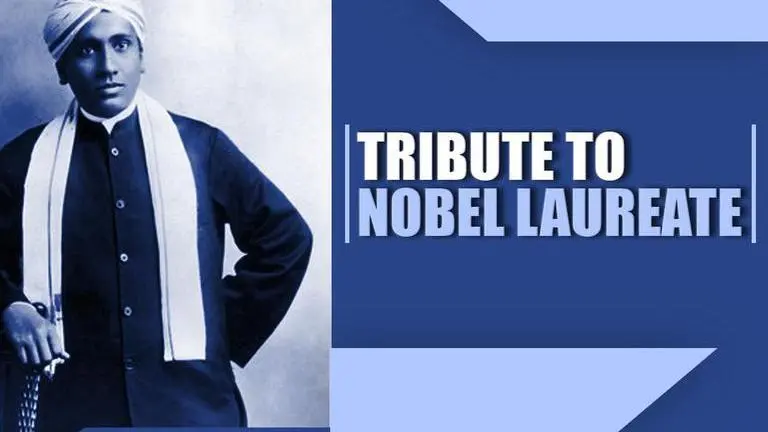Updated 21 November 2019 at 18:09 IST
CV Raman's death anniversary: Netizens pay tribute to India's first Nobel Laureate
November 21 marks the 49th death anniversary of first Asian Nobel laureate in physics, Sir Chandrasekhara Venkata Raman. Netizens pour in their tributes
- India News
- 4 min read

November 21 marks the 49th death anniversary of first Asian Nobel laureate in physics, Sir Chandrasekhara Venkata Raman, commonly known as CV Raman. Born in Trichinopoly, Tamil Nadu on November 7, 1888, CV Raman had carried out exceptional work in the field of light scattering. On his death anniversary, the nation pays homage to the Noble Laureate for his contribution to science which is illustrious and outstanding. Raman completed his study from the Presidency College in Madras and got a gold medal in physics. In 1917, while the British were ruling India, Raman started teaching physics at University of Calcutta.
His contributions to science
After India's independence in 1947, CV Raman became the director of the Raman Research Institute. Earlier in 1928, Raman had also led an experiment with KS Krishnan on the scattering of light when he discovered the phenomena of light which is now called the 'Raman effect'. This discovery also gave further proof of the quantum nature of light. This led to the discovery of Raman spectroscopy which is also based on the Raman effect. Raman along with Suri Bhagavantam also determined the spinning nature of photons in 1932 which was also confirmed the light's quantum nature. In 1933, Raman joined Indian Institute of Science, Bangalore and became its first director. He also employed a monochromatic light from a mercury arc lamp which penetrated transparent material and was allowed to fall on a spectrograph to record its spectrum. Raman also detected the lines on the spectrum, which were later known as 'Raman lines'.
Other investigations carried out by Raman are either experimental and theoretical studies on the diffraction of light by acoustic and ultrasonic and hypersonic frequencies which were also published from 1934 to 1942, along with the effects produced by X-rays on infrared vibrations in crystals when exposed to ordinary light. Raman was appointed as the first National Professor by the new government of India in 1947. During the post-independence period, Raman studied the spectroscopic behaviour of crystals and approached a unique manner for the fundamental problems of crystal dynamics. After leaving IISc in 1948, he remained the director of Raman Research Institute until he died in 1970 at the age of 82.
Advertisement
Netizens pay tribute
Raman won the Nobel Prize in Physics in 1930, and Bharat Ratna in 1954. The nation also celebrates February 28 as the National Science Day to commemorate his discovery of the Raman effect. Netizens took to their social media handles to pay their tributes to this great scholar.
Advertisement
Tribute to Nobel Prize Laureate, 'Bharat Ratna' Sir C. V. Raman on his death anniversary.
— Raksha Ramaiah 🇮🇳 (@RakshaRamaiah) November 21, 2019
He is the first Asian to ever win the Nobel Prize for his path breaking contributions to science.
He is credited with discovering the eponymous 'Raman effect'.#CVRaman pic.twitter.com/dzI4Q2qJNU
Remembering C.V.Raman, one of the greatest Indian scientists of the modern era on his death anniversary today. The first Indian to win a Nobel in Science, and the only Indian citizen too. pic.twitter.com/S0HZ7dxEYY
— Ratnakar #JaiShriRam (@GabbarSanghi) November 21, 2019
Offering tributes to the world’s finest physicist, Nobel Laureate, Bharat Ratna Dr. C V Raman on his death anniversary. His achievements will remain a source of inspiration for generations to come. #CVRaman pic.twitter.com/m10NClC7zo
— Sukhbir Singh Badal (@officeofssbadal) November 21, 2019
Remembering the great Era of World Physics,Nobel laureate, Bharatratna late Shri. C. V. Raman ji on his death anniversary...!!#CVRaman pic.twitter.com/FV8ZJrBksl
— पाटील श्रीतेज बाबासाहेब (@Patilshri7007) November 21, 2019
I pay my tributes to one of India’s greatest scientists, Sir C.V.Raman on his death anniversary today. Sri C V Raman was the first Asian to win a Nobel Prize in the field of Physics for his discovery of Raman scattering also called the Raman Effect.#CVRaman pic.twitter.com/hAMH3C5ie4
— शिव त्रिपाठी (@shiva_tripathi2) November 21, 2019
Published By : Aanchal Nigam
Published On: 21 November 2019 at 17:54 IST
